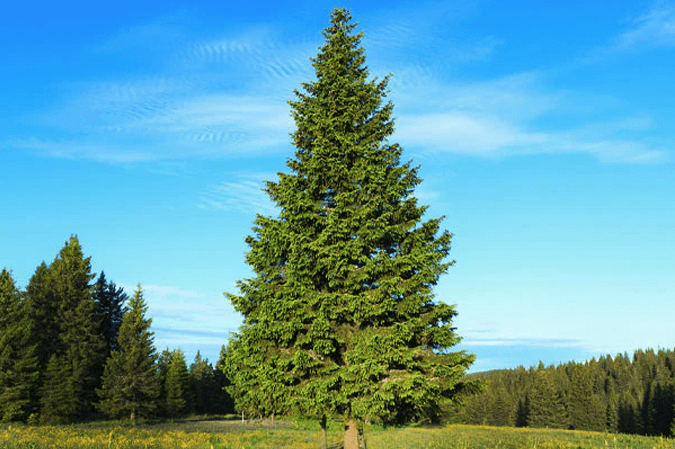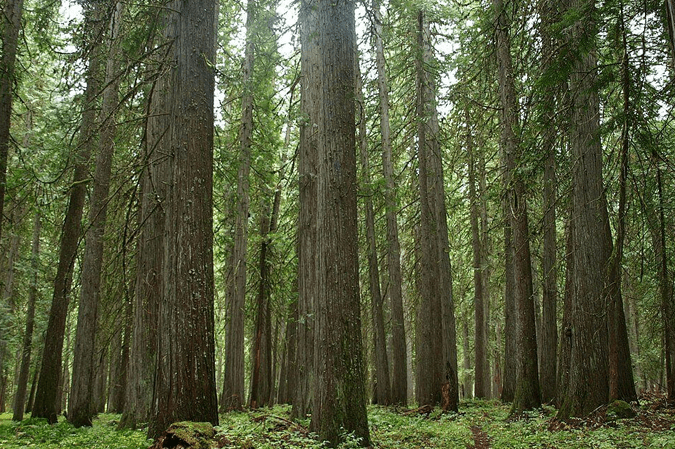Description:
Spruce trees belong to the genus Picea, comprising about 35 species of evergreen conifers native to the Northern Hemisphere. These trees are characterized by their conical shape, whorled branches, and needle-like leaves. Spruce trees are widely distributed across temperate and boreal regions and are an essential part of many forest ecosystems. They can grow to impressive heights, with some species reaching up to 60 meters (200 feet) tall.
Common Features:
- Needles: Spruce needles are stiff, pointed, and square in cross-section, making them easily rollable between fingers. They are attached singly to the branches and are typically 1-2 cm long. The needles are usually dark green to blue-green and remain on the tree for several years before being shed.
- Bark: The bark of spruce trees is thin and flaky, with a gray-brown color. It tends to become more deeply furrowed with age.
- Cones: Spruce trees produce cylindrical, hanging cones that are typically 4-10 cm long, depending on the species. The cones have thin, flexible scales and contain seeds that are dispersed by the wind.
- Roots: Spruce trees have shallow, wide-spreading root systems that provide stability in windy environments but can make the trees susceptible to windthrow.
Role in the Ecosystem:
Spruce trees play a vital role in their ecosystems, providing habitat, food, and other ecological services:
- Habitat: Spruce forests are home to a wide range of wildlife, including birds, mammals, insects, and fungi. Birds such as crossbills and chickadees rely on spruce cones for food, while mammals like squirrels and moose use the trees for shelter and nourishment.
- Carbon Sequestration: As evergreen trees, spruces are important carbon sinks, absorbing carbon dioxide from the atmosphere and storing it in their biomass. This helps mitigate climate change by reducing the amount of greenhouse gases in the atmosphere.
- Soil Stabilization: The extensive root systems of spruce trees help stabilize soil, reducing erosion and maintaining the integrity of forest floors, particularly in mountainous regions.
- Biodiversity: Spruce trees support a variety of organisms, including mycorrhizal fungi, which form symbiotic relationships with the tree roots, aiding in nutrient uptake and contributing to forest health.
Importance:
- Economic Value: Spruce wood is highly valued for its strength, lightness, and resonance. It is commonly used in construction, paper production, and musical instruments (such as the soundboards of pianos and guitars). The tree is also used for Christmas trees and ornamental purposes.
- Cultural Significance: In many cultures, spruce trees are associated with resilience and endurance due to their ability to thrive in harsh climates. Spruce wood has been used traditionally for building and crafting in northern regions.
- Environmental Importance: Spruce forests are crucial for maintaining biodiversity and ecological balance. They serve as a habitat for numerous species and play a significant role in the carbon cycle. In addition, spruce trees contribute to the hydrological cycle by regulating water flow in forested areas.
Interesting Facts:
- The Norway Spruce (Picea abies) is one of the most widely planted trees in Europe and is commonly used as a Christmas tree.
- The Sitka Spruce (Picea sitchensis), native to the Pacific Northwest of North America, is one of the tallest conifer species, with some individuals reaching over 90 meters (300 feet) in height.
- Spruce trees are among the oldest living organisms on Earth. The root system of a Norway Spruce in Sweden, known as “Old Tjikko,” has been radiocarbon-dated to be around 9,500 years old.
- Spruce resin has been historically used by Indigenous peoples for medicinal purposes, including treating wounds and respiratory ailments.
Sources:
- Royal Horticultural Society (RHS): Provides detailed botanical information and the ecological role of spruce trees.
- USDA Forest Service: Offers insights into the distribution, ecology, and uses of spruce species in North America.
- Woodland Trust: Includes information on the importance of spruce forests and their role in supporting biodiversity.
- Forestry Commission (UK): Details the economic value and management practices related to spruce trees, as well as their impact on forest ecosystems.
- Image Source: cdn.shopify.com



